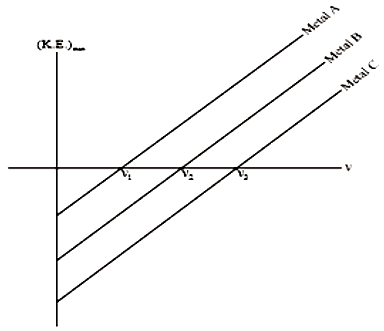The de-Broglie wavelength of a body of mass 1 kg moving with a velocity of 2000 m/s is
1.
2.
3.
4. None of these
Light of wavelength 4000 Å falls on a photosensitive metal and a negative 2V potential stops the emitted electrons.
The work function of the material (in eV) is approximately
1. 1.1
2. 2.0
3. 2.2
4. 3.1
The work functions for metal A, metal B, and metal C are respectively. Then-


1.
2.
3.
4. None of these
| 1. | \(\frac{m_1}{m_2} \) | 2. | \(\frac{m_2}{m_1} \) |
| 3. | \(1 \) | 4. | \(\sqrt{\frac{\mathrm{m}_2}{\mathrm{~m}_1}}\) |
An electron at rest is acceleration by a potential difference of 600V. The de-Broglie wavelength associated with the electron is:
1.
2.
3.
4.
For non-relativistic speeds, the wavelength associated with an electron and its kinetic energy E are related as:
1.
2.
3.
4.
If the momentum of a photon is p, then its energy is :
1. pc
2.
3.
4.
When the light of wavelength is used in a photoelectric experiment, the maximum kinetic energy of emitted electrons is found to be K. What will the maximum kinetic energy of the photoelectrons when the light of wavelength is used instead of :
1. Zero
2. Non zero but less than 2 K
3. 2K
4. More than 2K
Electrons used in an electron microscope are accelerated by a voltage of 25 kV. If the accelerating voltage is reduced to 6.25 kV, the resolving power of the microscope would:
1. Increase to 4 time
2. Increases to 2 times
3. Decrease to half
4. Decrease to 1/4th
The ratio of wavelengths of the last line of Balmer series and the last line of Lyman series is:
1. 2
2. 1
3. 4
4. 0.05






